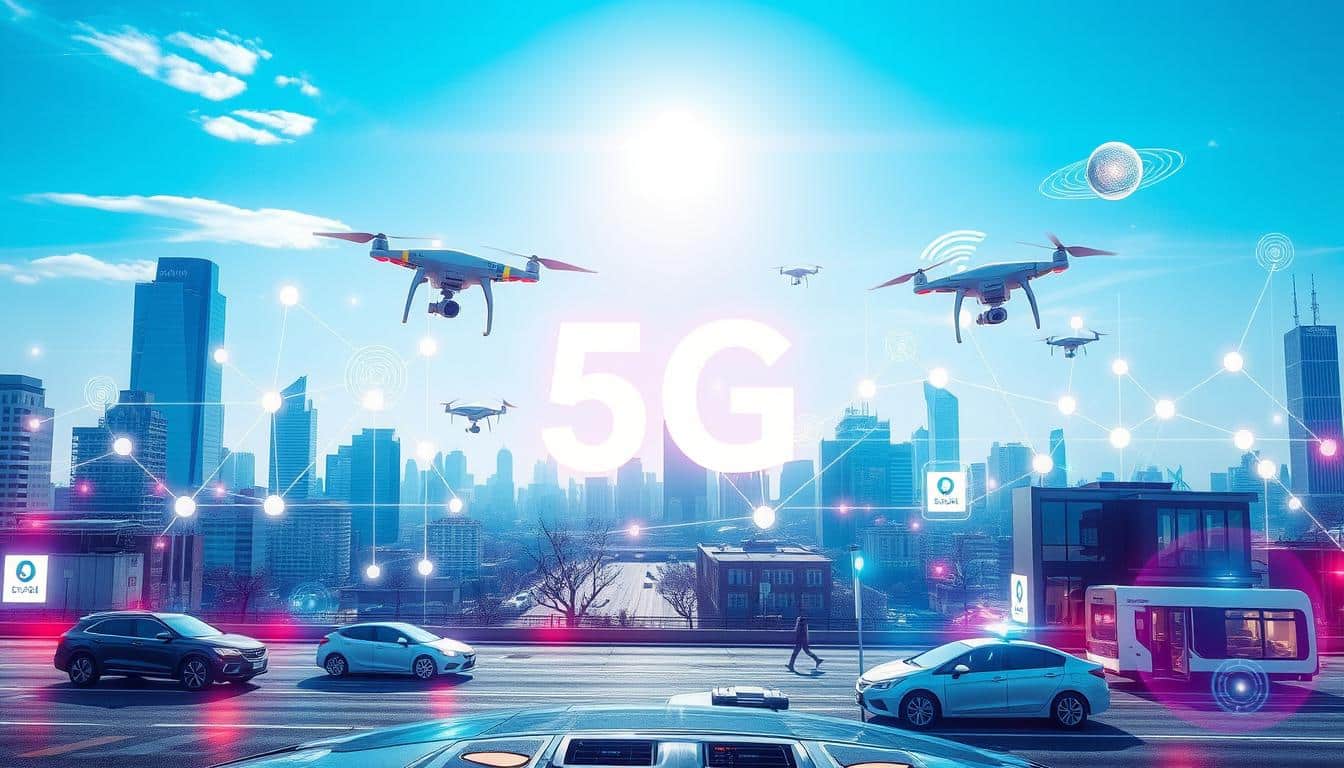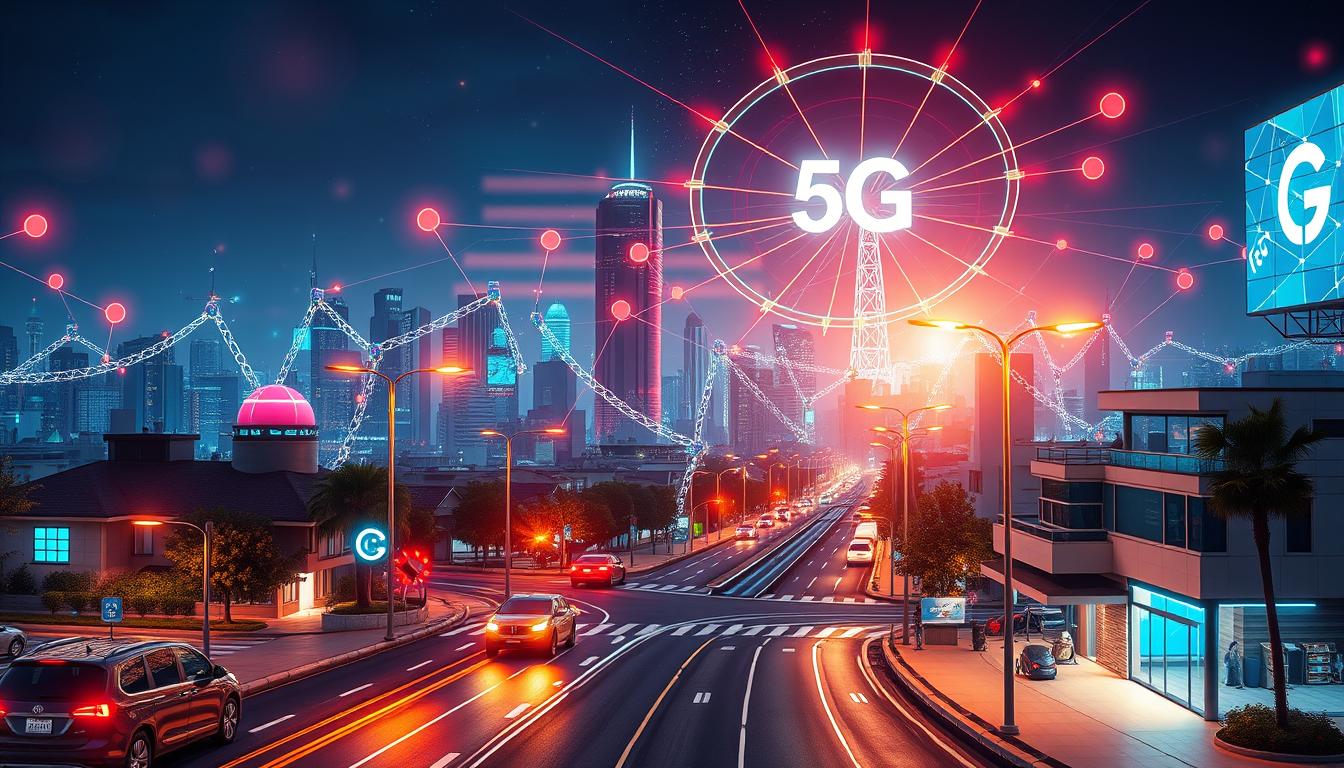5g Technology Impact The fifth-generation (5G) wireless technology is a big step forward in mobile networks. It brings new connections, capabilities, and services. From self-driving cars to remote surgeries, 5G will change how we communicate and share information.
5G is expected to be the most secure wireless network yet. This new generation offers chances to improve security and make things better for users. Keeping an eye on cyber threats is key, especially in areas like supply chains and network security.
Experts are worried about the risk of untrusted entities in the global supply chain. They also worry about the lack of vendor diversity and interoperability. The increased use of 5G infrastructure and integrating it with old networks are concerns too. There’s also a risk of untrusted custom code in ICT components.
Key Takeaways
- The number of connected devices is forecasted to increase from 9.7 billion in 2020 to 29 billion by 2030, signaling significant growth in the IoT market.
- 5G networks will be 10 times faster than current LTE networks, indicating a substantial increase in data-transfer speeds for IoT devices.
- IoT devices, including those in the healthcare and industry sectors, are expected to benefit from greater speeds provided by 5G networks.
- 5G technology offers faster and more secure data transmission services that can connect a new range of IoT devices and applications.
- 5G has been designed to support various IoT use cases, such as assisted driving, delivery robots, connected drones, and public safety applications.
The Transformative Power of 5G
The introduction of 5G technology is changing the world of telecommunications. It brings speed and reliability to many areas. The Enhanced Mobile Broadband (eMBB) feature of 5G offers high-speed mobile broadband.
Enhanced Mobile Broadband (eMBB)
5G eMBB can reach speeds of up to 10 gigabits per second. This means you can enjoy ultra-high-definition video without any issues. It also handles massive amounts of data smoothly.
This connectivity is perfect for new tech like virtual reality (VR) and extended reality (XR). They need low latency and fast data transfer.
5G can connect up to 1 million devices per square kilometer at once. This is key for advanced massive IoT applications. It will change many industries, like smart cities and industrial automation, by linking lots of devices together.
The reduced latency of 5G, as low as 1 millisecond, is a big deal. It’s great for mission-critical applications that need real-time responsiveness. This includes remote healthcare and self-driving cars.
“The transformative power of 5G is already influencing the healthcare industry by enabling more IoT devices for patient health monitoring, dependable connectivity for real-time results, and swift transmission of HD photos and videos for remote analysis.”
As more people use 5G, it will change many industries. This includes telecommunications, healthcare, smart cities, and industrial automation. With its amazing speed and connectivity, 5G will start a new era of innovation and productivity.
Massive Internet of Things (mIoT)

The 5G network is a big step forward for the Internet of Things (IoT). It can connect up to one million devices per square kilometer. This makes sure lots of devices can work together smoothly.
This is key for using IoT in smart ways, like in power plants and factories. It helps gather data for AI to make things smarter.
5G networks are fast and reliable. They let businesses use data in real-time and augmented reality in new ways. This is changing how we work in fields like healthcare and transportation.
| Mobile Network | Average Speed | Peak Speed |
|---|---|---|
| 2G | 0.1 Mbps | 0.3 Mbps |
| 3G | 3 Mbps | 7.2 Mbps |
| 3G (HSPA+) | 6 Mbps | 42 Mbps |
| 4G LTE | 20 Mbps | 150 Mbps |
| 4G LTE Advanced | 42 Mbps | 1 Gbps |
| 5G | 500-700 Mbps | 10 or 20 Gbps |
More devices are joining the IoT network, with 50 billion expected by 2030. 5G is fast enough to meet these needs. It’s up to 10 times faster than before.
This speed is crucial for businesses to keep up with the demand. It’s all about having enough bandwidth for more connected devices.
5G also has a cool feature called network slicing. It lets operators create special networks for different needs. This means better security measures for mobile devices and data transfer.
Mission-Critical Services (MCS)

5G technology has made a big leap forward with its reduced latency. This makes it perfect for critical tasks that need both speed and reliability. With latencies as low as a millisecond, 5G is great for tasks like autonomous vehicles, remote surgery, and industrial automation.
5G’s fast data transmission and low latency open up many opportunities for industries. It’s great for situations that need quick action, like remote intensive care units or augmented reality maintenance. 5G can change how we handle important tasks and emergencies.
For 5G mission-critical services to work well, strong security is key. We need to protect sensitive data and keep the network reliable. This is especially important for mobile devices and real-time data transfer.
As 5G becomes more common, the need for lower latency and higher reliability grows. By using 5G, companies can improve their work, safety, and innovation. This opens up new chances for growth in many areas.
| Key Benefit | Impact |
|---|---|
| Low Latency | Enables real-time data processing and transmission, critical for applications like autonomous vehicles and remote surgery. |
| High Reliability | Ensures mission-critical services can operate seamlessly, even in challenging environments or during emergencies. |
| Improved Efficiency | Allows for the deployment of innovative technologies and automation, boosting productivity and reducing costs. |
The possibilities of 5G for mission-critical services are endless. As it keeps improving, we’ll see even more groundbreaking uses. These will change how we handle critical tasks and emergencies in the future.
5g Technology Impact

The 5G technology revolution is changing our world in big ways. It offers new opportunities in many areas. With speeds up to 100 times faster than 4G, 5G is a game-changer. It brings new experiences, saves money, and uses lots of data to shape our digital future.
5G’s main strength is its ability to meet our growing need for smooth connections. It powers the Internet of Things (IoT) and brings new apps to life. From self-driving cars and remote health care to AR and fast data processing, 5G is leading a new tech era.
5G is expected to add $13.2 trillion to the global economy by 2035. It will also create 22.3 million jobs in the 5G value chain. This huge potential comes from 5G’s low latency, high bandwidth, and reliable connections. It’s making things that were once science fiction a reality.
“5G is set to revolutionize the way we live, work, and interact with the world around us. The speed and capabilities of this technology represent a significant leap forward in connectivity, unlocking a future filled with endless possibilities.”
As 5G grows, it will change our daily lives more and more. It will transform industries, make things more sustainable, and let people access info and services like never before. The impact of 5G is huge, shaping our digital world and driving the Fourth Industrial Revolution.
Cybersecurity and Supply Chain Risks
The introduction of 5G technology is a big step forward. It brings faster speeds, better connectivity, and the ability to handle huge amounts of data. But, it also brings new cybersecurity risks that need to be tackled.
Supply Chain Security
One major worry about 5G is the risk of untrusted entities controlling the global supply chain. The 5G network relies on many parts from different places. This makes it vulnerable if any part is not trustworthy. It’s crucial to have strong security measures to protect against these risks.
The fast data handling of 5G is a big plus. But, it also makes it harder to keep data safe from cyber threats. The speed and connectivity of 5G can lead to attacks that are too fast for old security systems. We need to keep up with new technologies and find ways to stay ahead of cyber threats.
| Cybersecurity Initiatives | Key Outcomes |
|---|---|
| Department of Homeland Security (DHS) led federal cybersecurity initiatives | Engagements such as the release of the Potential Threat Vectors to 5G Infrastructure paper |
| DHS announced a technical assistance pilot program for 5G security and deployment | Collaboration with FBI, DoS, DoD, FCC, and NTIA |
| DHS collaborated with NIST & FCC to develop 5G technical standards | Through ITU and 3GPP forums |
| DoD earmarked $600 million for 5G testbeds at five military sites in FY20 | Announced plans for a second phase at seven more sites in 2021 |
These efforts show the ongoing work to tackle the cybersecurity and supply chain risks of 5G. It’s a big step towards keeping connected devices and data in real-time safe.
Standards and Collaboration
The 5G technology revolution is moving fast. It needs strong standards and teamwork to work well and safely. The Department of Homeland Security (DHS) is leading the way. They are working on plans to make 5G safe and reliable.
CISA is teaming up with many groups to make sure 5G is secure. They want to make a system that is safe, reliable, and works well with others. This is a big job, but they are up for the challenge.
Here are some of the things they are doing:
- They are setting up testbeds and pilots to see how 5G works in real life.
- They are working with NIST and FCC to make sure 5G meets the right standards.
- They are teaming up with NSF and DoD to push 5G research and development.
- They are helping to make sure 5G systems are integrated safely and smoothly.
This shows the government’s dedication to working with the industry, telecommunications unions, and international partners. They want to make a strong 5G system that focuses on safety, security, and interoperability. By working together, the United States can be a leader in 5G research and development. This will help us avoid risks and make the most of this new technology.
“Effective standards and collaborative efforts are the cornerstones of a secure and interoperable 5G ecosystem. By working together, we can unlock the full potential of this transformative technology while prioritizing safety, security, and global leadership.”
Research and Development
The Department of Defense (DoD) leads in 5G testing and experimentation. They aim to change the nation’s warfighting capabilities. In FY20, they spent $600 million on 5G testbeds at five U.S. military sites.
This is the biggest 5G test for dual-use applications worldwide. The Department works with industry to test 5G. They focus on augmented and virtual reality training, smart warehousing, and distributed command and control.
The DoD is also setting up a team to watch international standards organizations. They seek new ways for dynamic spectrum sharing to speed up 5G deployment. This effort is part of a multiagency program and office.
They focus on research, development, funding, and priorities. Their goal is to invest in science and technology. This will shape the future of policy and capabilities for the U.S. military and industry partnerships.
“5G technology enables latency as low as one millisecond, significantly enhancing connectivity speeds.”
The DoD’s effort to advance 5G research and development shows its potential. It can change warfighting capabilities and industry partnerships. By investing in cutting-edge testing and experimentation, they aim to explore new areas.
Also Read : What Are The Environmental Impacts Of Blockchain Innovation?
Conclusion
The fifth-generation (5G) wireless technology is a big step forward. It changes how we connect and share information. It brings new connections and apps to the world.
Even though 5G is the most secure wireless network yet, it also has risks. These risks need to be handled carefully.
Cybersecurity experts are working hard to fix these problems. They focus on supply chain, infrastructure, and network security. They also aim for more diverse and compatible vendors.
Together, governments, industries, and international groups are creating the right rules. They want to make sure 5G is safe and works well.
5G will greatly change IoT devices and the digital world. It will make connections faster, more reliable, and quicker. This means better experiences in work, healthcare, entertainment, and more.
As 5G grows, it will change our world for the better. It will make our digital lives more connected, efficient, and safe.
FAQs
Q: What is the impact of 5G technology on IoT devices?
A: The impact of 5G technology on IoT devices is significant as it enhances connectivity, allows for the handling of vast amounts of data, and improves the overall performance of connected devices through higher speeds and lower latency.
Q: How does understanding 5G technology help in utilizing IoT?
A: Understanding 5G technology enables developers and businesses to leverage the capabilities of the fifth generation of mobile network, ensuring that IoT devices can fully utilize the opportunities presented by 5G, such as improved connectivity and efficiency.
Q: What challenges and opportunities does the rollout of 5G technology present for IoT?
A: The rollout of 5G technology presents challenges such as the need for new network infrastructure and security concerns, but it also offers opportunities like enhanced connectivity, faster data transfer rates, and the ability to support a larger number of IoT devices simultaneously.
Q: How does the low latency of 5G benefit IoT devices?
A: The low latency of 5G technology benefits IoT devices by enabling real-time communication and faster response times, which is crucial for applications such as autonomous vehicles and remote surgery.
Q: In what ways is 5G technology set to transform network infrastructure?
A: 5G technology is set to transform network infrastructure by introducing new architectures that support higher data speeds, improved energy efficiency, and greater capacity, which are essential for managing the increasing number of IoT devices.
Q: How can businesses navigate the challenges of 5G technology adoption in IoT?
A: Businesses can navigate the challenges of 5G technology adoption by investing in the necessary network infrastructure, staying informed on regulatory changes, and collaborating with technology partners to ensure a smooth transition to 5G-enabled IoT solutions.
Q: What advancements are expected with the widespread adoption of 5G in IoT?
A: The widespread adoption of 5G in IoT is expected to lead to advancements such as smarter cities, enhanced healthcare solutions, and more efficient supply chains, all benefiting from the high speed and connectivity that 5G technology brings.
Q: How does the speed of 5G affect the performance of IoT devices?
A: The speed of 5G greatly affects the performance of IoT devices by allowing for quicker data transmission, which enhances the functionality and user experience of applications that rely on real-time data and interactions.
Q: What role does artificial intelligence play in the context of 5G and IoT?
A: Artificial intelligence plays a crucial role in the context of 5G and IoT by enabling smarter analytics and decision-making processes, allowing devices to learn from data patterns and optimize their performance in real time, thus leveraging the opportunities presented by 5G technology.


